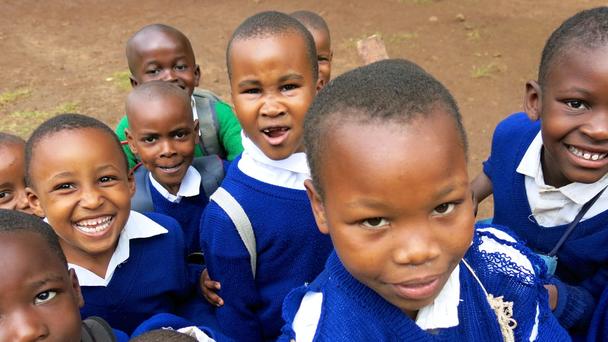
School children jostle for attention
(Richelle Harrison Plesse)
HIDE CAPTION
School children jostle for attention
(Richelle Harrison Plesse)
Each year, more than 50,000 people set out to climb Africa’s highest peak, joining a revered tribe of dedicated adventurers. But in the shadow of Mt Kilimanjaro, nestled in the foothills, another tribe reigns supreme. The Chagga clan, one of more than 260 tribes in Tanzania, has been living in the laidback village of Marangu since the 19th Century, and their descendants, the Bantu people, began migrating to this area along the slopes of Kilimanjaro in the early 11th Century. The village’s mountain landscape, interlaced with streams and picturesque waterfalls, gave Marangu its name, meaning “place of water”.
More than just a starting point for the mountain’s most popular climbing route, Marangu welcomes those who spend more time here with green gorges, fields awash in banana groves and coffee plantations. It also gives insight into a fascinating local lifestyle and culture – an experience that most travellers miss. For those who linger, a cultural tour led by a dedicated guide is the key to discovering Marangu’s charms, for beyond its modest, one-road centre, centre, the rest of the village – hidden by swathes of jungle – is difficult to navigate alone.
We met our guide Ludovic Tilya outside the Babylon Lodge, a handsome budget hotel with simple but comfortable rooms set amid lush tropical gardens, located a short stroll from the centre of town. The previous night’s rains had cleared to reveal glorious blue skies, and we set off on a winding muddy track that led to the village’s forest-fringed back streets. Locals threw curious glances our way; in these lesser-travelled lanes, mzungu (white people) visitors are few and far between.

- Scenes from Marangu. (Richelle Harrison Plesse)
We weaved in and out of luxuriant banana groves peppered with the odd coffee plant, Royal Poinciana tree (also known as the flamboyant tree due to its flamboyant display of brilliant, flame-red flowers) and yucca. The latter, Ludovic said, holds spiritual significance for the Chagga people, who also use its leaves for weaving, healing purposes or as a symbolic means of settling disputes (much like the offering an olive branch). A smattering of pretty, petite houses peered out from behind manicured gardens, a surprise against the surrounding untamed greenery.
Rounding a corner we crossed a clearing, where a trio of young children was playing a game of Ring Around the Rosie. There were shy giggles when they spotted us, but they let their guard down as soon as they saw our cameras, insisting on playing with the dials and scrolling through the pictures we’d taken. A few steps away was a local primary school where recess had begun, and where boisterous boys and girls in cobalt blue uniforms laughed and chatted excitedly. Happily posing for a few snaps, they jostled for our attention, but stern words from the head teacher sent them running and they disappeared in an instant.
Leaving the kids behind, we set off in search of a local banana beer brewer. Bananas are big business in Tanzania – in fact, the succulent yellow fruit is the staple food of the local Chagga people and the twice-weekly Marangu market is the country’s largest for the sale of the regional specialty. Banana buyers come from all over the country, with local women clad in brightly patterned kangas (cotton wraps) peddling their finest, freshest produce.

- The twice-weekly Marangu market. (Richelle Harrison Plesse)
We found the “brewery” – a small wooden hut set among a banana plantation – deeper in the Marangu jungle. An elderly, heavy-set woman pruned the banana trees, while an enormous cauldron filled with the fruity tipple bubbled over a nearby open fire. Known locally as mbege, the concoction of millet and bananas is the traditional brew of the Chagga people. With most of the work done by hand without any help from modern technology, its production is a lengthy and labour-intensive process. The result is a sweet, slightly sour boozy beverage, one that’s knocked back at several Chagga festivities, including weddings, births, rites of passage and even wakes. Later in the day, we came across a group of locals gathered at an open-air bar to pay tribute to a deceased loved one, swigging from small buckets to drown their sorrows after the funeral.













